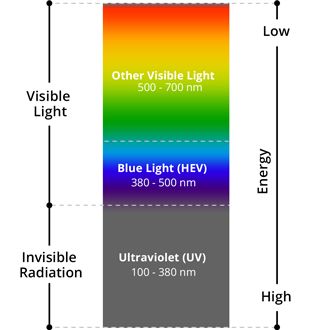Altec Lansing Life Jacket No Blinking Blue Light
Blueish light: what you should know

Visible lite is much more complex than you might retrieve.
Stepping outdoors into sunlight; flipping on a low-cal switch indoors; turning on your computer, phone or other digital device — all of these things result in your eyes being exposed to a multifariousness of visible (and invisible) rays that can have a range of effects.
Nearly people are aware that sunlight contains visible light rays and also invisible ultraviolet rays that tin can tan or fire the skin. What many don't know is that the visible calorie-free emitted past the sun comprises a range of different-coloured light rays that contain different amounts of free energy.
What is blueish light?
Sunlight contains red, orange, yellow, green and bluish light and many shades of each of these colours, depending on the energy and wavelength of the individual rays (besides chosen electromagnetic radiations). Combined, this spectrum of coloured calorie-free rays creates what nosotros call "white lite" or sunlight.
The low-cal spectrum
Without getting into complicated physics, at that place is an inverse human relationship betwixt the wavelength of light rays and the amount of energy they comprise. Light rays that have relatively long wavelengths contain less energy, and those with short wavelengths take more energy.
Rays on the scarlet finish of the visible light spectrum have longer wavelengths and, therefore, less energy. Rays on the blueish finish of the spectrum have shorter wavelengths and more energy.
The electromagnetic rays just beyond the red end of the visible light spectrum are called infrared — they are warming, but invisible. (The "warming lamps" yous see keeping food warm at your local eating place emit infrared radiations. These lamps too emit visible carmine calorie-free and then people know they are on! The same is true for other types of heat lamps.)
On the other finish of the visible light spectrum, blue light rays with the shortest wavelengths (and highest free energy) are sometimes chosen blue-violet or violet light. This is why the invisible electromagnetic rays just beyond the visible light spectrum are called ultraviolet (UV) radiation.
The perils and benefits of UV
UV rays have college free energy than visible lite rays, which makes them capable of producing changes in the skin that create a suntan. Tanning beds used to emit a controlled amount of UV radiation specifically for this reason.
As well much exposure to UV causes painful sunburn or even worse can pb to pare cancer. These rays also can cause sunburned eyes a status called photokeratitis or snow blindness.
Ultraviolet radiation, in moderation, also has beneficial effects, such every bit helping the body manufacture adequate amounts of vitamin D.
By and large, scientists say the visible calorie-free spectrum comprises electromagnetic radiation with wavelengths ranging from 400 nanometers (nm) on the bluish finish of the spectrum to about 700 nm on the red terminate. (Past the way, a nanometre is one billionth of a metre — that'southward 0.000000001 metre!)
Bluish lite generally is divers every bit visible light ranging from 400 to 500 nm. Blue light sometimes is farther cleaved down into blue-violet light (roughly 400 to 455 nm) and blue-turquoise lite (roughly 465 to 495 nm).
So "blue" light, approximately ane-3rd of all visible lite, is considered high-energy visible (HEV).
Key points well-nigh blue light
Similar ultraviolet radiation, visible blue light — the portion of the visible light spectrum with the shortest wavelengths and highest energy — has both benefits and dangers. Hither are important things you should know about blue light:
1. Bluish light is everywhere.
Sunlight is the main source of blue calorie-free, and beingness outdoors during daylight is where it is most prevalent. There are as well many homo-made, indoor sources of bluish light, including fluorescent and LED lighting and apartment-screen televisions.
Compared to older devices, the brandish screens of computers, electronic notebooks, smartphones and other digital devices emit higher amounts of blue light. Nonetheless, the amount of HEV low-cal these devices emit is only a small fraction of that emitted past the lord's day..
WORRIED ABOUT BLUE LIGHT? Discover an optometrist nearly yous.
2. HEV light rays make the heaven look blue.
The short-wavelength, loftier-energy light rays on the blueish terminate of the visible light spectrum scatter more than easily than other visible light rays when they strike air and water molecules in the atmosphere. The higher caste of scattering of these rays is what makes a cloudless sky look blueish.
three. The center doesn't filter bluish low-cal.
Anterior structures of the developed man heart (the cornea and lens) are very effective at blocking UV rays from reaching the light-sensitive retina at the back of the eyeball. In fact, less than one percentage of UV radiations from the sun reaches the retina, even if you aren't wearing sunglasses.
(Continue in mind, that sunglasses that cake 100 percent of UV are essential to protect these and other parts of the eye from damage that could lead to cataracts, snow blindness, a pinguecula, pterygium, and even cancer.)
On the other hand, nigh all visible blue light passes through the cornea and lens and reaches the retina.
4. Blue lite exposure may exist a take a chance factor in macular degeneration.
The fact that bluish light penetrates all the way to the retina (the inner lining of the back of the centre) is of import, because laboratory studies have shown that exposure to blue light can impairment lite-sensitive cells in the retina. This causes changes that resemble those of macular degeneration, (AMD) which can pb to permanent vision loss.
Although more inquiry is needed to determine how much blue light is "likewise much blueish light" for the retina, many practitioners are concerned that for people at risk of AMD, blue light exposure outdoors might increase their chances of developing macular degeneration afterward in life.
Common adventure factors include: a history of directly family unit members with AMD; smoking; poor diet and obesity; sure photosensitising medications and an outdoor occupation with higher sunlight exposure.
5. Blue light contributes to digital center strain.
As curt-wavelength, high free energy blue light scatters more easily than other visible lite, it is not as easily focused. When you're looking at computer screens and other digital devices that emit blueish light, this unfocused visual "noise" reduces contrast and can contribute to digital heart strain.
Research has shown that lenses that block blue light with wavelengths less than 450 nm (blue-violet light) increase contrast. Therefore, spectacles with appropriate blue filtering lenses may increment comfort when yous're viewing digital devices for extended periods of fourth dimension.
6. Blueish light filtering may be of import afterward cataract surgery.
The lens in the adult man eye blocks nearly 100 percent of the sun's UV rays. Every bit part of the normal ageing procedure, the centre'due south natural lens eventually blocks some short-wavelength blue light too.
If you lot take cataracts and are most to have cataract surgery, ask your surgeon what type of intraocular lens (IOL) volition be used to supervene upon your cloudy natural lens, and how much blue light filtering the IOL provides
seven. Benefits of blue light.
It's well documented that some blue lite exposure, peculiarly the wavelengths from 465 to 495nm, is essential for good health. Enquiry has shown that high-free energy visible light boosts alacrity, helps memory and cerebral office and elevates mood.
In fact, something called low-cal therapy is used to care for seasonal melancholia disorder (SAD) — a blazon of depression that'due south related to changes in seasons, with symptoms usually beginning in the autumn and continuing through wintertime. The low-cal sources for this therapy emit bright white light that contains a higher amount of HEV blueish light rays.
Blue light is likewise very of import in regulating circadian rhythm — the body's natural slumber/awake bicycle. Exposure to blue low-cal during daytime hours helps maintain a healthful circadian rhythm but likewise much blue low-cal belatedly at dark (reading a novel on a tablet computer for an hour or then at bedtime, for example) can disrupt this cycle, potentially reducing slumber quality and daytime fatigue. Blue lite also helps control our pupil response to lite.
Blue light filters
If yous accept one of more of the risk factors for developing AMD, when outdoors you tin can wear appropriate plano or prescription sunglasses or Transitions lenses.
Digital electronic devices emit blue light that tin cause eye strain and may lead to centre issues over fourth dimension.
These also give UV protection and reduce lord's day-glare. Wraparound sun-wear prevents side-on exposure which besides helps preclude pterygia on the eye and fifty-fifty skin cancers on the delicate skin around the optics. If you are concerned merely don't wish to vesture either sunglasses or Transitions lenses, clear lenses with an appropriate blue light filter can be prescribed past your optometrist.
If you lot are using your phone constantly — especially if yous use it primarily for emailing and web browsing — a user-friendly way to increase dissimilarity is to use a blue light filter.
These filters are available as apps or overlays for smartphones, tablets, and computer screens and reduce bluish lite from these devices without affecting the visibility of the display. Some are fabricated with thin tempered glass that also protects your device'south screen from scratches.
If you habiliment glasses there are a number of options to increase contrast past reducing blue calorie-free from digital devices. Whether you wear progressive lenses, specific computer glasses or just ordinary lenses there are blue filters bachelor.
A number of lens manufacturers have introduced special anti-reflection coatings that also filter blueish light for both sunlight and digital devices. You also may desire to consider photochromic lenses, which filter blue light indoors and out and provide seamless protection from UV as they automatically darken in response to UV rays outdoors to increment comfort and reduce glare.
Inquire your optometrist nearly which blazon of vision correction and lens features best suit your vision needs and if blue light filtering should be included.
Folio published on Monday, xvi March 2020
Page updated on Sat, 25 July 2020
Source: https://www.allaboutvision.com/en-au/digital-eye-strain/blue-light/
0 Response to "Altec Lansing Life Jacket No Blinking Blue Light"
Post a Comment